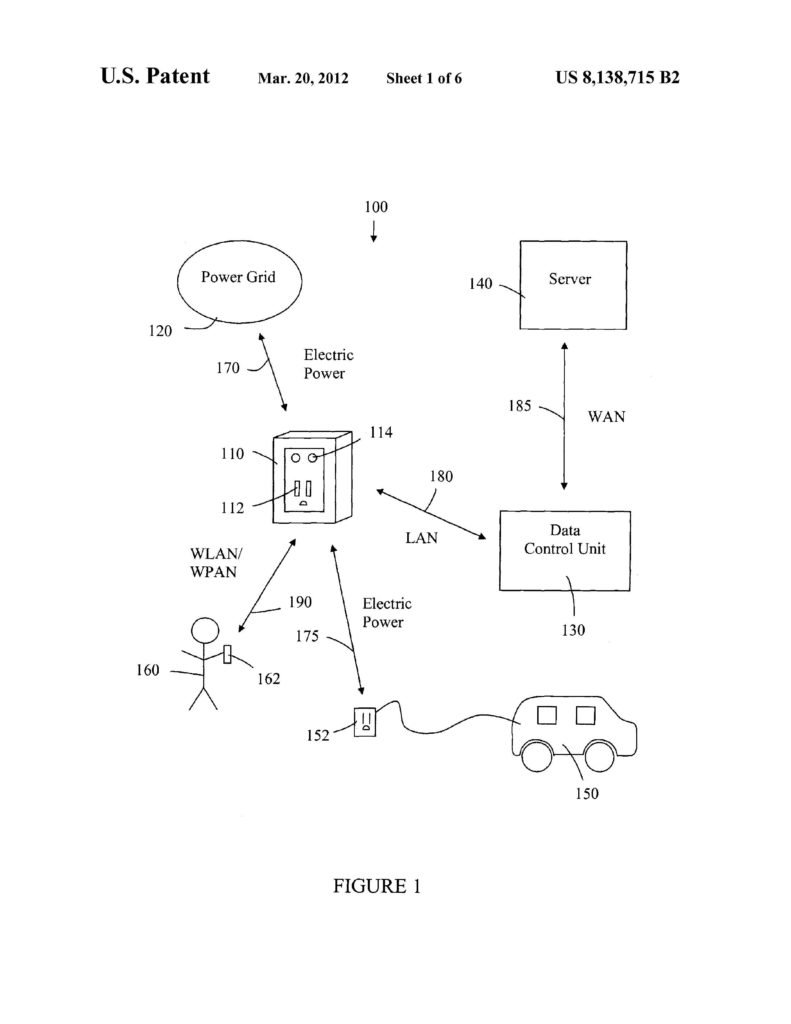ChargePOINT, INC. v. SemaCONNECT, INC., FEDERAL CIRCUIT 2019 (SOFTWARE PATENTS)
 This is a software patent decision in which the court ignored a substantial amount of hardware in the patent claim and found that the claim was directed to an abstract idea and therefore invalid. In the Alice Supreme Court decision, the main issue was whether the patentee took a well known financial method and merely automated it on a computer. In most post-Alice decisions, the computer was largely ignored in determining whether the claim was directed to an abstract idea and therefore unpatentable under 35 U.S.C. 101, unless there was an improvement in operation of the computer.
This is a software patent decision in which the court ignored a substantial amount of hardware in the patent claim and found that the claim was directed to an abstract idea and therefore invalid. In the Alice Supreme Court decision, the main issue was whether the patentee took a well known financial method and merely automated it on a computer. In most post-Alice decisions, the computer was largely ignored in determining whether the claim was directed to an abstract idea and therefore unpatentable under 35 U.S.C. 101, unless there was an improvement in operation of the computer.
The ChargePOINT case relates to U.S. Patent No. 8,138,715; 8,432,131; 8,450,967; and 7,956,570 for charging stations for electric vehicles. The battery in an electric vehicle is recharged by connecting the vehicle to an electrical outlet. At the time the patent application was filed, this process typically required hours and was often done overnight or while the electric vehicle was parked for a significant amount of time.
Businesses such as restaurants, apartments, and shopping centers have installed electric vehicle charging stations for the convenience of their customers. A shopping center may prefer to offer free vehicle charging to its customers to encourage customers to continue shopping.
Utility companies have different concerns in mind. Generally, the supply of electricity available from a power grid may vary, and in some cases the grid may lack sufficient electricity to meet demand. In addition to pulling electricity from a local electricity grid, electric vehicles may also supply electricity to the grid.
ChargePoint contends that its inventors created improved charging stations that address the various needs inherent in electric vehicle charging. This was accomplished by creating networked charging stations. According to ChargePoint, this network connectivity allows the stations to be managed from a central location, allows drivers to locate charging stations in advance, and allows all users to interact intelligently with the electricity grid.
Claim 1 of the ‘715 patent is representative and recites:
1. An apparatus, comprising:
- a control device to turn electric supply on and off to enable and disable charge transfer for electric vehicles;
- a transceiver to communicate requests for charge transfer with a remote server and receive communications from the remote server via a data control unit that is connected to the remote server through a wide area network; and
- a controller, coupled with the control device and the transceiver, to cause the control device to turn the electric supply on based on communication from the remote server.
The Federal Circuit noted that it is clear from the language of claim 1 that the claim involves an abstract idea—namely, the abstract idea of communicating requests to a remote server and receiving communications from that server, i.e., communication over a network. But at step one, “it is not enough to merely identify a patent-ineligible concept underlying the claim; we must determine whether that patent-ineligible concept is what the claim is `directed to‘, citing Thales Visionix. In trying to discern what the claim is directed to, the Federal Circuit considered the problem being solved. The problem identified by the patentee, as stated in the specification, was the lack of a communication network that would allow drivers, businesses, and utility companies to interact efficiently with the charging stations.
The Federal Circuit stated that, looking at the problem identified in the patent, as well as the way the patent describes the invention, the specification suggests that the invention of the patent is nothing more than the abstract idea of communication over a network for interacting with a device, applied to the context of electric vehicle charging stations. The Federal Circuit then agreed with SemaConnect that, based on the claim language, claim 1 would preempt the use of any networked charging stations. The Federal Circuit stated that the inventors here had the good idea to add networking capabilities to existing charging stations to facilitate various business interactions. But that is where they stopped, and that is all they patented. The Federal Circuit therefore held that claim 1 is “directed to” an abstract idea.
I have a degree in electrical engineering and that sounds like a lot of hardware to me, in addition to just a computer or microprocessor. 35 U.S.C. 101 states that: Whoever invents or discovers any new and useful process, machine, manufacture, or composition of matter, or any new and useful improvement thereof may obtain a patent therefor, subject to the conditions and requirements of this title.
This sure sounds like a machine. The judicial exception that prevents abstract ideas from being patented relates to the concern that we don’t want to have patents covering mental steps or laws of nature or natural phenomenon. This claim covers none of these things.
The main sin of the patentee is that their claim was arguably too broad. But if that was the case, the claim should also be obvious and that is where the court should have focused its analysis. Since it was a “good idea,” maybe it wasn’t so obvious.